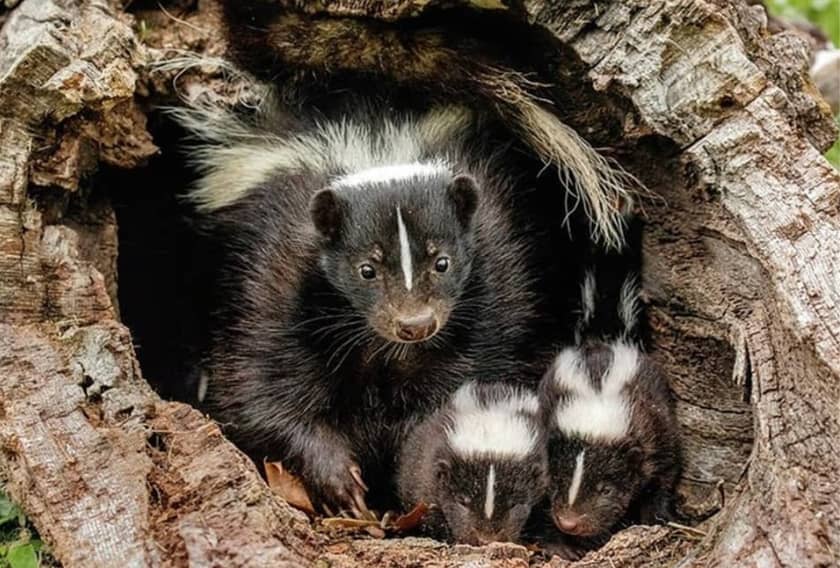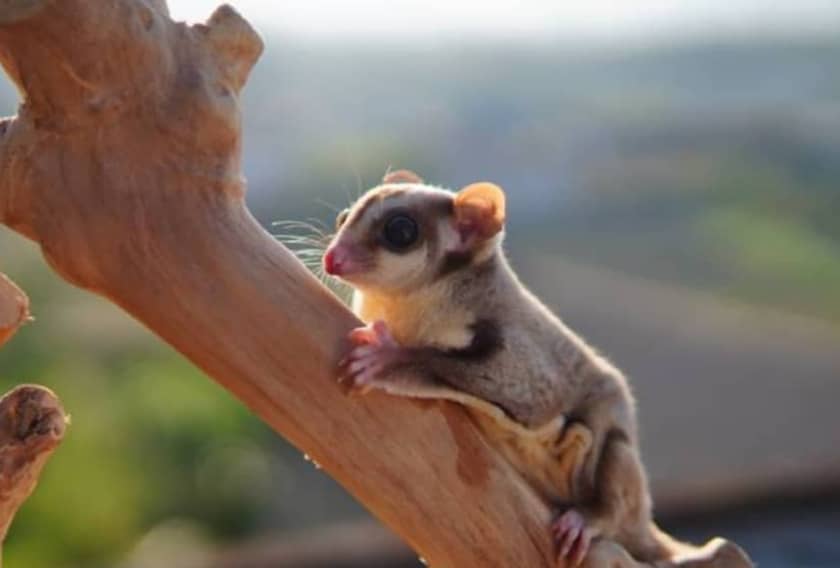Many interesting facts about flying squirrels make them unique creatures. Flying squirrels are known for their ability to glide from one tree to another with the help of a wing-like structure on their body. Despite being able to fly, these creatures are similar to regular squirrels.

However, flying squirrels tend to be nocturnal beings who subsist primarily on fruit, insects, and seeds. Flying squirrels build nests in trees to hold their young.
Flying Squirrel Facts
The peculiarity of the flying squirrel has piqued the interest of owners of exotic pets. The following are some fascinating details about their lifetime, morphology, adaptability, and disposition.
Lifespan
In the wild, flying squirrels live about 5 to 6 years, however, in captivity, they can live up to 10 years or more due to better protection and a consistent food supply.
Size Information
The size of flying squirrels varies depending on the species. Most are small, with the southern flying squirrels weighing about 8 to 10 inches long (including the tail) and weighing 2 to 3 ounces. On the other hand, the Indian giant flying squirrel can reach up to 3 feet in length, including its tail, and weigh around 3 pounds.
Origin
Flying squirrels are believed to have originated in Asia, where the vast majority of species still exist today. Their ability to glide has allowed them to adapt to a wide range of environments, from dense forests to urban areas.
Some Interesting Facts About Flying Squirrel
The interesting facts about flying squirrels intrigue curiosity about their anatomy and adaptation.
Wide Range of Species
There are more than 50 species of flying squirrels that differ from each other in terms of their gliding capacities, physical features, and regions they are found in. In central and southern China, the red-and-white giant (Petaurista alborufus) is rather widespread. It can grow to a length of more than 3 feet (1 meter) and weigh up to 3 pounds (1.5 kilograms).
Flying Squirrels Have Adorable Eyes for Night Vision
Big, round eyes are one reason flying squirrels look so cute to humans. But those eyes are not just for show. Their big eyes are specially adapted for night vision, allowing them to see clearly in the dark. This is crucial because flying squirrels are nocturnal, meaning they are most active at night.

They evolved big eyes to collect more light for better night vision. Their enhanced night vision helps them navigate through the trees, find food, and avoid predators in the dark, so those adorable eyes are a key to survival too!
Flying Squirrels Can Glow at Night
Flying squirrels have a cool trick—they can glow in the dark! When you shine ultraviolet light on them, their fur lights up with a bright pink or orange color. This glow is called fluorescence. Scientists aren’t exactly sure why they glow, but it might help them to other squirrels or hide from predators. This glowing ability makes flying squirrels even more amazing!
Flying Squirrels Don’t Fly
Despite their name, flying squirrels don’t fly. Instead, they glide through the air using a flap of skin called a patagium that stretches between their front and back legs. This allows them to travel from tree to tree without touching the ground.
Flying Squirrels Can Glide 300 Feet and Make 180-degree Turn
Flying squirrels are incredible gliders. They can glide as far as 300 feet (about 90 meters) in a single leap! Not only that, but they can also make sharp 180-degree turns while gliding, allowing them to quickly change direction and avoid obstacles or predators.

They glide through the air using a flap of skin called a patagium that stretches between their front and back legs. Their gliding skills help them move easily through the forest. This allows them to travel from tree to tree without touching the ground.
Baby Flying Squirrels Need a Lot of Mothering
Answer Baby flying squirrels rely heavily on their mothers for survival. The mother takes care of them warmly until they are old enough to glide and find food on their own. During the first few days of their lives, the young continuously squirm while emitting faint squeaks.
Their ears open within two to six days of birth, and they develop some fur after about a week. Their eyes don’t open for at least three weeks, though, and they remain dependent on their mother for several months.” The young become independent by 4 months old unless overwinter as a family.”Without this care, the babies wouldn’t survive in the wild
Some Flying Squirrels are Larger Than a House Cat!
The Indian Giant Flying Squirrel, native to parts of Asia, can reach up to 3 feet in length, including its tail, making it larger than some house cats. These giant squirrels have large, wing-like membranes that allow them to glide long distances, sometimes over 300 feet in a single glide.
Flying Squirrels Specialized Diet
Flying squirrels have a varied diet that includes nuts, seeds, fruits, fungi, and insects. Northern flying squirrels, in particular, have a unique relationship with truffle fungi, which they eat and help spread throughout the forest. This makes them important for maintaining healthy forest ecosystems.
Flying squirrels Are Sometimes Considered Pests!
To reduce the chances of finding flying squirrels in your attic, be sure to have holes in roofs and loose siding fixed. Additionally, make sure all vents and openings to the chimney have fitted covers. Preventing these little rodents can be difficult.
Besides sealing all possible points of entry around the house, pay close attention to small openings and cracks around doors and windows. This will help with a lot of different pests, including squirrels, but the fact that these squirrels can “fly”, may not be effective for them.
Flying Squirrels Do Not Hibernate
Flying squirrels have a unique mechanism to slow down their metabolic rate and can enter into a state called “torpor.” By doing so, they remain inactive and warm and hence conserve energy.
Where Do Flying Squirrels Live?
The southern flying squirrel feeds on nuts, acorns, seeds, berries, some insects, and bird eggs, and will even eat meat if it’s available. Some food is stored in the nest chamber and also in tree crotches.
The northern flying squirrel feeds primarily store much food for winter use. They inhabit coniferous and mixed forests, where they prefer dead trees with numerous woodpecker holes for nesting, especially in stumps 6-20 feet high and those near the top. They have also been known to use the attics of buildings to build their nest.
Flying Squirrels Fake Death!
Flying squirrels sometimes show a peculiar act of faking their death to grab the attention of their owners.
Health-Related Interesting Facts About Flying Squirrels
Flying squirrels are known for amazing adaptations and health-related facts. Some of these are
Strong Immune System:
Flying squirrels have a robust immune system that helps them survive in various environments, from warm climates to cold northern forests.
Disease Carriers:
While flying squirrels are generally healthy animals, they can carry diseases that may be transmitted to humans, such as typhus and leptospirosis.
Nutrient-rich Diet:
A flying squirrel’s diet, rich in nuts, seeds, fruits, and fungi, provides them with the essential nutrients. The variety in their diet ensures they get enough vitamins, minerals, and protein.

Dental Health:
Like all rodents flying squirrels’ teeth never stop growing. They must constantly gnaw on hard objects, such as nuts and bark, to keep their teeth from becoming too long. It is crucial for their overall health and ability to eat.
Social Health Benefits:
Flying squirrels often live in small family groups, especially in colder climates. This social behavior not only helps them stay warm but also reduces stress, contributing to their overall well-being
Interesting Facts Sheet about Flying Squirrels



